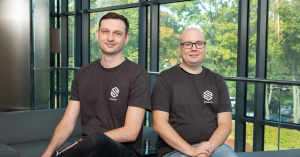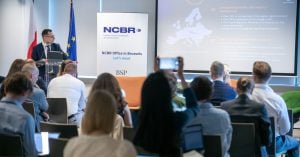He juggles effectively between his roles as Chief Strategy Officer at automation leader UiPath and Managing Director of Crew Capital, a VC investing across the US and Europe, in early-stage startups offering B2B software across the stack of applications, infrastructure, and cybersecurity, as well as categories such as fintech, digital health and e-commerce infrastructure. He draws on his experience in an operational role at a unicorn-level scaleup to offer practical advice to founders in his portfolio. And he believes the new AI hype cycle is unlike any other in the past and will revolutionize industries across the world.
Brandon Deer joins us for an insightful interview about leadership, venture capital, and AI. He talks about the latest portfolio developments at UiPath, how the biggest AI summit of the company unfolded, and what he thinks about the future of AI. We also learn about his mindset and due diligence process as an investor, and what differentiates the startup ecosystems of Europe and the US.
The Recursive: You are leading your own venture capital company, while also driving the strategy of one of the global business automation leaders. What is your secret for managing these two demanding and different roles in parallel?
Brandon Deer: There is not really a secret sauce. They’re both demanding and time-intensive. I’m wearing both hats, while doing my best to maintain a healthy lifestyle. In order to keep the balance, I need a lot of consistency. I have a very structured schedule, both during the week and on the weekends. I prioritize meetings, as well as my travel, rigorously.
And, you know, I’d be lying if I said I don’t also benefit from really great lieutenants under me at both UiPath and Crew Capital, who I trust and respect.
The last thing I’ll mention about it is that there’s great synergy between the roles. In my operational role at UiPath I get to experience a lot of things on a daily basis that help me then offer really practical advice to founders facing day-to-day challenges in today’s macro environment. Advice that goes beyond the typical financing type of work that most investors bolster a lot of strength from.
Daniel (ed.note – Daniel Dines, the co-founder and co-CEO at UiPath) and I have been partnering together for more than five years, growing the business, adding customers, servicing them, and shipping new products every single day. We’ve had up-and-down cycles, all these give us a lot of empathy for the challenges that founders of all stages face. We can say: “we’ve seen something similar, and here’s how we thought about it and what action we took”.
Conversely, I learn a lot from the founders within our portfolio. And not just professionally, but on a personal level, too. I benefit from their experiences, from their learnings and their network, in a way that I didn’t necessarily expect, but has been very rewarding so far.
As part of UiPath, you are helping lead the business automation revolution. Where is UiPath today versus 5 years ago when you joined the company?
Brandon Deer: We’ve changed quite a lot across a number of dimensions. We’ve expanded into 30+ countries all over the world. We’ve gone from what was a single-product company to a multi-product company. We started with the Core Automation Studio and Orchestrator and the bots, and now we have entirely new pillars of products for discovery, management, running analytics, and different components of AI. This enables us to solve new pain points for our customers. The UiPath Business Automation Platform comprises over 20 products, over 10,000 customers, and 4,000 employees today.
In terms of our financial profile, in Q4, which ended in January 2023, we crossed $1.1 billion in revenues, growing almost 20% year-over-year. We believe we’re in a really strong position as a market leader within business processes automation to continue growing at a healthy pace, in an operationally-efficient manner, adding operating leverage on both top line and bottom line growth.
How does UiPath marry the startup and corporate mentalities today?
Brandon Deer: As companies experience growth and expansion, they often face various dichotomies, such as the balance between speed and process or the tension between traditional and modern practices.
Then, if you’re a European-founded business expanding to the US, you’ll likely encounter a cultural clash initially, and you will need to adapt your way of doing business to the new reality and region, being mindful of the differences. Or if you have cross-functional teams, it’s important to be aware that there may be clashes between departments such as sales, marketing, and finance.
That is why it’s crucial to establish effective communication channels and encourage collaboration to ensure that everyone is aligned toward the same goals. This will help avoid friction and ensure that your team is working toward a common objective. As the company grows, the challenges that you need to solve become more complex.
At the end of the day, I think you can solve this by doing two things. Firstly, you need to set a high bar for talent, bring the smartest people around you, people that have not just been there and done it, but have a real drive and desire to solve problems. Secondly, you need to instill a culture that is psychologically safe for everyone, embraces humility and a mindset that says you don’t need to have all the answers. I’m more than willing to admit that I don’t have all the answers or when I am wrong, but then I can assure you that I’m going to figure it all out.
UiPath recently hosted its annual AI Summit. What were your main takeaways from this edition?
Brandon Deer: Our first major summit dedicated to AI was an unbelievable event for practitioners and AI customers who are currently leveraging different models to run business processes and automate on top of them. The event was also suited for people who haven’t yet started using those types of technologies, but are really interested in the benefits of AI for their businesses.
I’ve heard about the AI hype cycle for over 10 years, as both product manager and now at UiPath. And I can tell you that this one is different. I think that the world has finally found a way to embrace AI for solving real business needs and operationalizing everyday processes. That’s why I believe AI is here to stay and it will become pervasive across companies of all sizes and industries, and across the world.
At UiPath, we’ve had AI embedded quite early into several aspects of our business automation platform. The core principles have always been the same: to be open, flexible, and enterprise-ready. We built AI into things like our document-understanding products, process mining and clipboard AI.
We’ve also always allowed our customers to bring their own data models. There have been many investments into data science teams and companies using their own data to try and create models that will parse through that information and come up with a more probabilistic approach to what an outcome might be. We’re not so silly as to think that we have to own all of these models ourselves – we’re more than happy to have our customers bring them. We’re also happy to partner with other great third-party vendors like Open AI, Amazon, and Google.
I’m excited about what this new AI hype cycle means for the entire tech ecosystem and customers who embrace this type of technology.
You said on social media: “if AI is the brain, then automation is the arms and legs”. Can you share more on this topic?
Brandon Deer: In the past, most Robotic Process Automation (RPA) deployments were fairly straightforward. Bots were simply augmenting humans with simple and frequent repeatable tasks, any sort of data movement or routine day-to-day activities. That’s where the low hanging fruit for RPA was.
The AI initiatives that I mentioned previously have been formed from the belief that RPA needs AI and AI needs RPA. RPA needs AI to automate all the steps in a workflow that are really difficult to find and define, because they have a high variability and require a more probabilistic approach.
Conversely, AI needs RPA because these data models have always lacked a sufficiently robust vehicle to bring them into the operational fold of the business. For instance, if I have one of these AI models deployed, if I didn’t build it I wouldn’t necessarily know how it’s used – whether I need a new piece of software for every single model deployed, or how to manage it. These models will only be operationalized if they’re truly plugged into the business process seamlessly.
This is exactly the channel of opportunity that RPA presents, by being sold into the business to solve a problem. AI can be quickly embedded within our Studio to provide all the benefits without any of the complexity of managing and requiring the involvement of data scientists.
Where do you see the role of humans alongside this integration between AI and automation?
Brandon Deer: I have an interesting analogy for this question. I remember many years ago when IBM came out with the Watson supercomputer and had it play a match against the former chess champion of the world. The supercomputer won, and as a result, there was a lot of fear around the idea of robots taking over the world.
Yet that fear never fulfilled itself. In fact, globally, unemployment is at an all time low and productivity is at an all time high, while work-life balance is in a much stronger place than all those years ago. And the best chess players today are not robots, however, they are not humans either. They are teams made of humans and robots.
I think man+machine is where the world is going. And that’s what’s going to drive the best outcomes for us. It has also always been a big part of UiPath’s vision, as a company accelerating human achievement. In the end, it’s not about accelerating the achievement of robots, but of humans, through augmentation with virtual robots.
What was the mission and unique approach to investment that you brought to the market with Crew Capital?
Brandon Deer: Daniel and I were at a TechCrunch event in Berlin a few years ago. UiPath was growing very quickly, we were launching new products and there was a lot of good media coming out about an upcoming IPO. At the event, we had many young founders coming our way, wanting to chat about their business, to bounce ideas off and get advice. They were essentially asking for one of two things: time or money. In some cases, they wanted both.
I had worked in investing before at a venture capital firm and I knew the dynamics of creating an investment funnel, conducting diligence, and winning a deal to get into a really high-quality company. What I came to realize was that it is not easy for professional investors to get into the best companies, because many VCs were fighting over them. In our case, we had a completely inverted dynamic: we had high-quality entrepreneurs coming up to us and asking for help, asking us to be involved in their businesses. As a result, that night we first formed the idea of investing together, building our playbooks and bringing a support team around to help these companies, as we have experienced ourselves in our company building journey.
I remember there were certain founders whom we trusted and reached out to be our trusted source of information, because they had previously built large enterprise software companies, had gone public, and had done it years before us. We wanted to take that and kind of pay it forward in a sense, and institutionalize it in a way where we can replicate it more frequently.
What elements do you find most conducive to a good investor-founder match?
Brandon Deer: There are some really high-level investment firms that typically have a particular area of focus, either a category or a stage or both. At Crew Capital, for instance, we spend all of our time on the B2B software category. Daniel and I have only shipped products that are B2B-oriented and sold products that are B2B sales. In terms of stage, we focus on the earliest stage companies, from pre-seed to series A. This is where we get the most energy and where we know we can be most helpful. That’s level one of understanding whether there is an investor-founder match, and founders can assess that as simply as doing some cursory diligence on the firm’s website.
I think the next level is really about the partner and the founder, not so much the firm. These relationships are often very hard to break up, harder than a marriage, and they can last for a very long time. In terms of the attributes that I care a lot about, I would mention passion, trustworthiness, and being people-oriented, which in my view is critically important. When it comes to company building, culture is a key factor that can make or break a business. If you break your culture along the way, you lose your heart and soul, and that makes it really hard to keep people motivated or to attract new talent.
What are the key factors and elements you look at when assessing a startup as a potential investment?
Brandon Deer: There’s a very long list of things that we diligently check, and it goes beyond just these key attributes. We look at the founders’ vision, their acumen, whether they are able to potentially sell the product in the future. In terms of the company itself, we run lots of financial due diligence, we look at the dependencies of a particular market, how much budget exists within those markets, the propensity and density of the buyers. We do a deep dive assessment on the technological architecture, the scalability, the types of languages and open source projects that they’re building on top to ensure that they’re employing the best available technology.
But a long list doesn’t mean that it’s extremely time intensive. We’ve run this process enough times to get very quick and thoughtful about the time that we use up from the company.
What is your experience with fostering innovation in both US and European startup ecosystems?
Brandon Deer: At Crew Capital, most of our investments are split between the US and Europe. Because we have that global preview, we’ve been put in a position to foster collaboration and facilitate thought leadership within our portfolio, diverse insights and mindful advice on scaling in Europe that may or may not apply to the US, and vice versa. Therefore, within our portfolio, we have a blend of Eastern and Western perspectives and approaches, creating an East-meets-West dynamic, and we see it occurring every day within our WhatsApp, Slack, and other community channels.
On the other hand, there is a lot of similarity between the mistakes that get made, regardless of whether you’re founded in the US or in Europe. These include sacrificing quality in hiring in the name of moving faster, caring too much about control and power versus empowering your employees to find their path and to really take accountability for their work, taking on too much, and so on. Being thoughtful about investing in the things that will actually move the ball, is crucial. On top of that, if you take on too many things at once, sometimes, you may start to lose touch with the voice of the customer, which for early stage startup is paramount.
What advice would you give to European founders looking to scale to the US?
Brandon Deer: A lot of the barriers for starting a business in Europe and then moving over to the US have been taken down slowly with software. Decentralized work, cross-border payroll, general productivity and collaboration, all these have been addressed with tools, even across the largest companies in the world.
To expand to the US, or in any other region for that matter, you need to have someone on the ground whom you really trust to act as a lieutenant and be the culture-carrier. That’s important for maintaining the values and mission of the company. They need to have a good leadership style to ensure that the business is scaling there in a way where you have the proper visibility. You need to ensure that there is a system where everyone has the same goals, mission and business metrics that the company is striving for. Startups grow at such a fast pace that the amount of tasks that you’re taking on every day is constantly expanding. There can be an unbelievable amount of pressure. Still, I always say that pressure is a privilege.








